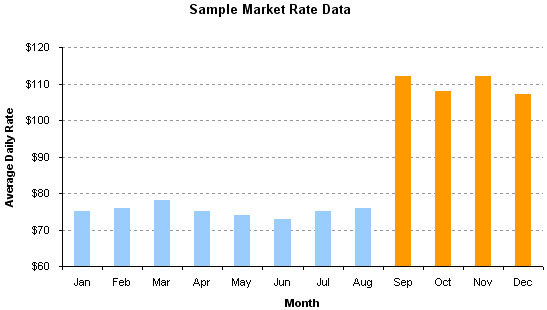Factors Influencing Lodging Rates
Introduction
Historically, GSA has worked with federal agencies, travelers, and the travel industry to improve the process of establishing federal lodging per diem rates. Since Fiscal Year 2005, lodging per diem rates are based on average daily rate (ADR) data, which is a widely accepted lodging-industry measure based upon a property's room rental revenue divided by the number of rooms rented as reported by the hotel property to the contractor. The purpose of this page is to discuss four factors that influence the ADR that may result in the federal lodging per diem rates to differ from published market rates. These four factors are:
A. Property Selection Criteria
B. Time Frame of Data
C. Seasonality
D. Methodological Rate Adjustors
It is important to note that each factor's impact varies by market. A detailed description of each factor follows:
A. Property Selection Criteria
Part of the GSA's Per Diem methodology for determining market rates involves collecting Average Daily Rate (ADR) data from specific properties that meet the GSA criteria. The ADR is a widely accepted lodging-industry measure based upon a property's room rental revenue divided by the number of rooms rented as reported by the hotel property to our contractor, Smith Travel Research (STR). This calculation provides GSA with the average rate that rooms rent in a given area.
Our criteria includes geography (i.e., zip codes to which federal employees travel), fire safe certification, and various property demographics (STR's Chain Scale for example). STR ranks properties into luxury, upper upscale, upscale, mid-scale, and economy categories. The goal of the selection criteria is to choose properties best representing mid-range hotels in each market.
B. Time Frame of Data
For the FY09 Per Diem Study, GSA used ADR data generated from April 2007 to March 2008. The ADR data is based on travel between Monday and Thursday.
C. Seasonality
To better represent seasonal rate fluctuations, GSA has created seasonal rate periods in many markets where there is a sustained period (two or more months in length) where rates (ADR) are different from the preceding or following period by at least 15%. If there is an ADR difference between 10 and 14% of a sustained period and the occupancy rate level for this same period is 70% or over, this period also becomes a season. Once a season has been defined, the ADR for all seasons is computed using the current lodging data ending in March. GSA uses the same properties for rates and seasonal determination, however three year's worth of data are used to determine seasons. The graph below shows an area with two seasons. GSA uses the same properties for rates and seasonal determination, however three year's worth of data are used to determine seasons.

D. Methodological Rate Adjustors
In addition to the factors addressed above, GSA also places floor/ceiling caps on year-over-year rate fluctuations, meaning that rates rarely increase or decrease more than $49 from last year's published Per Diem rate. The only instance where rates might be greater or less than the ceilings and floors are if an "orphan" season is created where there is only one month at a given rate. In those situations, an orphaned rate will become part of the preceding or following rate (whichever rate is closest).
Last Reviewed 9/30/2008